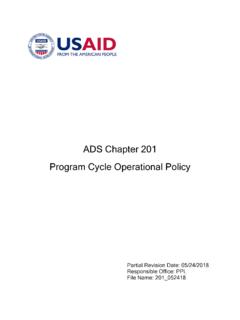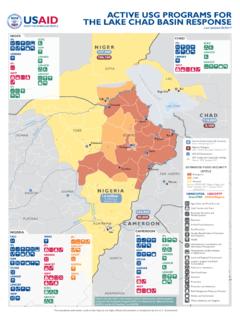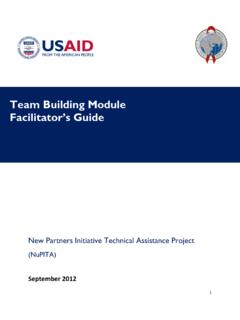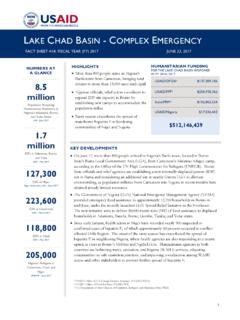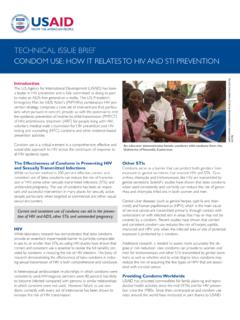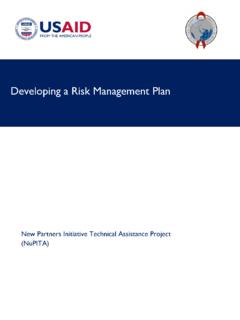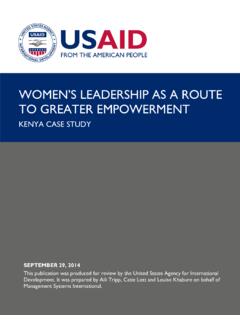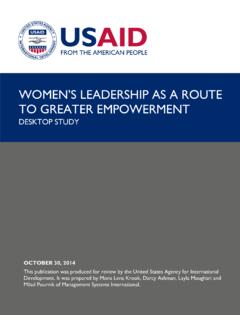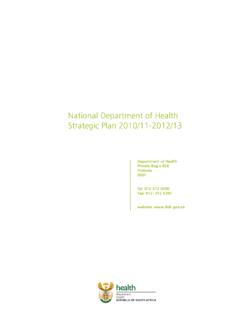Transcription of Ending Preventable Maternal Mortality
1 Tesy of Photoshare Courumar Ghatak,Asit K 2012 Ending Preventable Maternal Mortality :USAID Maternal Health vision for Action Evidence for strategic Approaches January 2015 ii | Ending Preventable Maternal MortalityUSAID Maternal Health vision for Action | Evidence for strategic Approaches | 1 ABBREVIATIONS AND ACRONYMSAMTSL Active management of the third stage of laborANC Antenatal careARR Annual rate of reductionART Antiretroviral therapyBEmONC Basic emergency obstetric and newborn careCDC Centers for Disease Control and PreventionCEmONC Comprehensive emergency obstetric and newborn careCOIA Commission on Information and AccountabilityC-section Cesarean sectionCPR Cardiopulmonary resuscitation DHS Demographic and Health Survey(s)EMOC Emergency obstetric careEPCMD Ending Preventable child and Maternal deathEPMM Ending Preventable Maternal mortalityGH USAID Bureau for Global HealthHTSP Healthy timing and spacing of pregnanciesIFA Iron folic acidIPTp Intermittent preventive treatment in pregnancy for malariaKMC Kangaroo Mother CareLAM Lactational amenorrhea methodLMIC Low- and middle-income countriesM&E Monitoring and evaluationMCH Maternal and child healthMDG Millenium Development GoalMDSR Maternal Death Surveillance and ResponseMICS Multiple Indicator Cluster SurveysMMR Maternal Mortality ratioNGO Nongovernmental organizationNIH National Institutes of HealthOECD Organization of Economic Cooperation and DevelopmentPAC Post-abortion carePE/E Pre-eclampsia/eclampsiaPMTCT Prevention of mother-to-child transmission of HIVPNC Postnatal carePPH Postpartum hemorrhagePPF Postpartum family planningSBA Skilled
2 Birth attendantSBR Stillbirth rateSTI Sexually transmitted infectionTB TuberculosisUBT Uterine balloon tamponadeUNFPA United Nations Population FundUSAID Agency for International DevelopmentUTI Urinary tract infectionWASH Water, sanitation and hygieneWHO World Health Organization 2 | Ending Preventable Maternal MortalityTITLETABLE OF CONTENTS5 Executive Summary7 Introduction8 What s New in the strategic Approaches?8 A Bold vision : Ending Preventable Maternal Mortality 10 Achieving the vision Is Possible12 USAID s strategic Focus12 USAID Will Focus Geographically on 24 Countries 12 Where Most Maternal Deaths Occur 13 Where Fertility Remains High 13 Where Rural Areas Still Dominate 15 Using the Maternal Health vision for Action: Evidence for strategic Approaches at Country Level 15 Building on USAID s Development Capacity 16 Building on Global Efforts17 Achieving the vision : strategic Drivers to Prevent Maternal Mortality 18 Enabling and Mobilizing Individuals and Communities 18 strategic DRIVER 1: Improve Individual, Household, and Community Behaviors and Norms 19 strategic DRIVER 2: Improve Equity of Access to and Use of Services by the Most Vulnerable 21 Advancing Quality, Respectful Care21 strategic DRIVER 3: Strengthen Integration of Maternal Services with Family Planning 23 strategic DRIVER 4.
3 Scale Up Quality Maternal and Fetal Health Care27 strategic DRIVER 5: Prevent, Diagnose, and Treat the Indirect Causes of Maternal Mortality and Poor Birth Outcomes 30 strategic DRIVER 6: Increase Focus on Averting and Addressing Maternal Morbidity and Disability 32 strategic DRIVER 7: Advance Choice and Respectful Maternity Care and Improve Working Conditions for Providers 33 Strengthening Health Systems and Continuous Learning 33 strategic DRIVER 8: Strengthen and Support Health Systems 37 strategic DRIVER 9: Promote Data for Decision-Making and Accountability 38 strategic DRIVER 10: Promote Innovation and Research for Policy and Programs 39 Reaching Vulnerable Women and Ensuring Life-Saving Care for All 41 Going Forward 42 References50 Glossary53 Contributors and Acknowledgements USAID Maternal Health vision for Action | Evidence for strategic Approaches | 3 Figures 10 Figure 1: Toward Ending Preventable Maternal Mortality (EPMM) Worldwide Reaching MMR of 70 in 2030 11 Figure 2: Reaching Global MMR=70 by 2030: Maternal Mortality Ratio Declines by Countries Less than and Greater than MMR of 420 (2010 baseline), 1990 2030 12 Figure 3: MMR in 24 USAID MCH Priority Countries (2013) 13 Figure 4: Annual Rates of Reduction (1990 2013) within USAID MCH Priority Countries 14 Figure 5: Number of Live Births by Year in Sub-Saharan Africa and Southern Asia, 1950 2050 14 Figure 6: Population Breakdown by Urban/Rural in USAID MCH Priority Countries (2012) 17 Figure 7: Achieving the vision for Improved Maternal and Fetal Health and Survival 19 Figure 8: Use of Maternal Health Services in USAID MCH Priority Countries over a Decade, Asia and Africa 20 Figure 9: Utilization of Maternal Health Services in Bangladesh, Malawi, and USAID MCH Priority Countries by Wealth Levels, 2007 2010 22 Figure 10.
4 Maternal Mortality Ratio by Age and Birth Order 23 Figure 11: Modern and Traditional Method Utilization and Unmet Need among Married Women in USAID MCH Priority Countries24 Figure 12: High Impact Practices Proven Interventions Can Address Leading Causes of Maternal Death25 Figure 13: Interconnections between Maternal , Fetal, and Immediate Newborn Health and Interventions 27 Figure 14: Primary Causes of Maternal Death, South Africa, 2005 2007 29 Figure 15: Prevalence of Anemia in Pregnant Women in USAID MCH Priority Countries30 Figure 16: Annual Maternal and Newborn Mortality and Morbidity, 2008 2010 34 Figure 17: Percent of All Births in Asian Countries by Facility Type in Three Recent DHS Surveys35 Figure 18: Number of Midwives per 1,000 Live Births in USAID MCH Priority Countries, 2011 36 Figure 19: Proportion of Delivery Rooms that Are WASH Safe, by Category and Type, Tanzania, 200640 Figure 20: The Framework for ChangeTables39 Table 1: Measuring Progress in the USAID MCH Priority Countries: Coverage Indicators and TargetsBoxes31 Box 1: What Is Maternal Morbidity?
5 33 Box 2: Saving Mothers, Giving Life39 Box 3: Implementation Principles 4 | Ending Preventable Maternal MortalityUSAID Maternal Health vision for Action | Evidence for strategic Approaches | 5 Executive SummaryThe Government is committed and working toward the goal of Ending Preventable Child and Maternal Deaths (EPCMD) in a generation. In June of 2014, the Agency for International Development (USAID)released a vision for Maternal health, Ending Preventable Maternal Mortality : USAID Maternal Health vision for Action. The document lays out a vision for a world where no woman dies from Preventable Maternal causes and ma-ternal and fetal health are improved and sets out a plan for USAID to contribute to accelerating reductions in the Maternal Mortality ratio (MMR) and improving Maternal and fetal health with targets for 2020. This document, Ending Prventable Maternal Mortality : USAID Maternal Health vision for Action, Evidence for strategic Approaches, lays out the evidence that will help achieve this vision .
6 Maternal Mortality has nearly halved over the past two and a half decades, yet 289,000 women worldwide still die each year as a result of pregnancy and childbirth. As Mortality has declined, disparities have become more apparent. The risk of death is disproportionately highest among the most vulnerable women in the poorest of nations. Yet, most Maternal deaths are Preventable as are many of the other poor health consequences of pregnancy. Among the 189 million women who are pregnant an-nually, 122 million have a live birth, and nearly 3 million suffer a stillbirth. About 10 percent of mothers suffer a Maternal complication during pregnancy or in the intra-partum period, and up to 40 percent may have morbidi-ties or disabilities post-birth that are attributable to the pregnancy or birth. Among all babies born, 15 million are preterm, and 1 million of these will die within the first week; many more are born small for gestational age.
7 The toll of death and ill health related to pregnancy and birth adversely affects not only mothers and children s health, but also their development and ability to contribute productively to their communities and societies. Further-more, the financial costs of Maternal complications and ill health and associated problems for newborns are a drain on families and to affordable, high quality, respectful Maternal health care is fundamental to the survival of pregnant and childbearing women and girls, as well as newborns. It includes access to services, goods, and information and the removal of inequities. Yet, discrimination impedes a woman from her right to access such maternity care due to age or marital status or to social, cultural, racial, ethnic, geographic, economic, legal, and political barriers. Women s lack of agency to utilize services contributes to needless death and suffering. Beyond lack of decision-making au-thority, women are less likely to have control over or access to the financial resources needed to pay for transportation and direct or incidental fees for Maternal services.
8 Weak health systems, including those lacking leadership or management or having inadequate staffing and sup-plies, underlie poor care and contribute to the poor health outcomes. Inadequate financing and budgetary allocations, as well as poor infrastructure (space, water, sanitation, and electricity), poor or disjointed information systems and lack of use of data for improved policy formulation and implementation, ensure weak systems remain weak. Ending Prventable Maternal Mortality : USAID Maternal Health vision for Action, Evidence for strategic Approaches sets out a plan for USAID to contribute to driving accelerated MMR Dave Burrows/Jhpiego 6 | Ending Preventable Maternal Mortalityreduction and improving Maternal and fetal health from now through 2020 by: Focusing geographically on the 24 USAID Maternal and Child Health (MCH) priority countries. Promoting 10 strategic drivers that together: - Enable and mobilize individuals and communities to improve healthy behaviors, expand use of appropri-ate services, and hold health systems accountable.
9 - Advance quality, respectful care that reduces Maternal morbidity, disability, and Mortality and improves fetal health. - Strengthen health systems and continuous learning to support the system of care needed from pregnancy through the postpartum period. Ensuring that we reach the most vulnerable by incorpo-rating consistently applied approaches for action in all Prventable Maternal Mortality : USAID Maternal Health vision for Action, Evidence for strategic Approaches provides technical evidence for the each strategic driver. It recog-nizes and builds on the changing landscape of programs and knowledge since the 2003 USAID Maternal health strategy. Specifically, it incorporates programming related to the increasing proportion of Maternal deaths due to indirect causes, the need to improve fetal health, and the opportunities and challenges presented by increasing urbanization, decentralization, privatization, and the new financial initiatives.
10 It acknowledges the need for better information and data to ensure accountability for quality respectful care through national and global advocacy as well as information in the hands of citizens to know their rights and the means to act on them. Ending Prventable Maternal Mortality : USAID Maternal Health vision for Action, Evidence for strategic Approaches, however, is not prescriptive; it provides a broad selection of strategies and leaves the strategy selection to those in-country. It also does not cover the baby once born (see the Every New-born Action Plan PMNCH 2014; Salam et al., 2014). What Ending Preventable Maternal Mortality : USAID Maternal Health vision for Action, Evidence for strategic Approaches means USAID Bureau for Global Health (GH) will work alongside USAID Missions, governments, and partners in countries with MCH funding to use the Ending Preventable Maternal Mortality : USAID s Maternal Health vision for Action and Ending Prventable Maternal Mortality : USAID Maternal Health vision for Action, Evidence for strategic Approaches documents to inform country programs.
